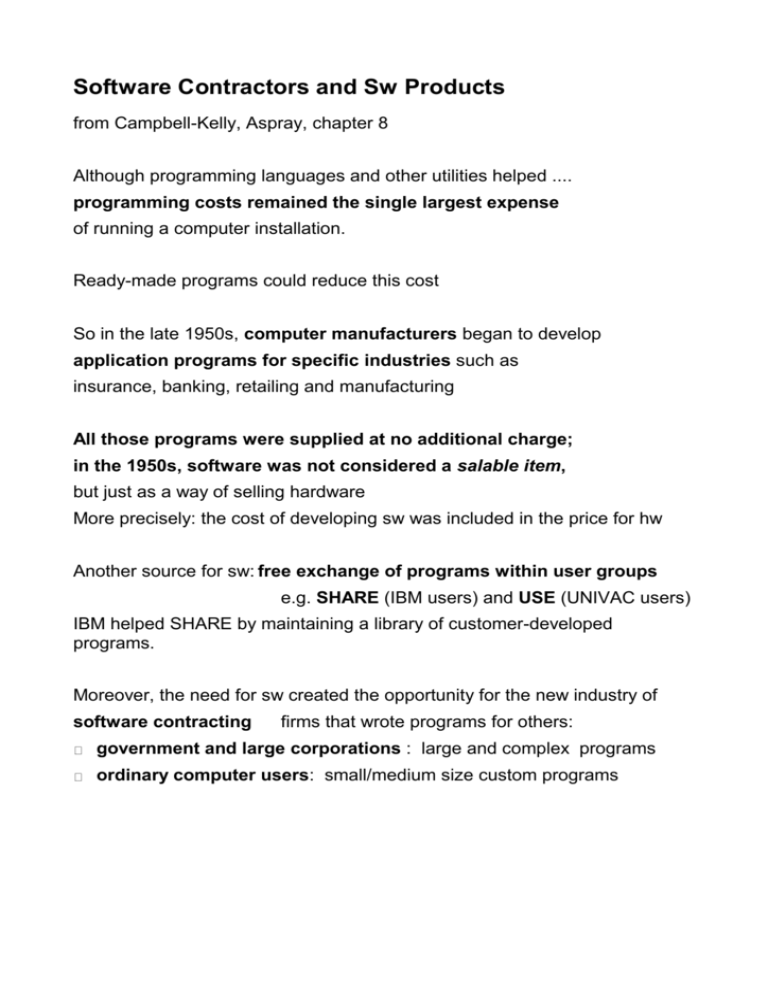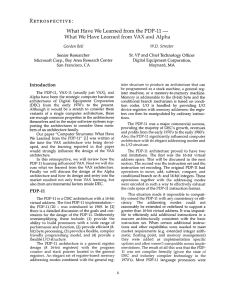Software products
advertisement

Software Contractors and Sw Products from Campbell-Kelly, Aspray, chapter 8 Although programming languages and other utilities helped .... programming costs remained the single largest expense of running a computer installation. Ready-made programs could reduce this cost So in the late 1950s, computer manufacturers began to develop application programs for specific industries such as insurance, banking, retailing and manufacturing All those programs were supplied at no additional charge; in the 1950s, software was not considered a salable item, but just as a way of selling hardware More precisely: the cost of developing sw was included in the price for hw Another source for sw: free exchange of programs within user groups e.g. SHARE (IBM users) and USE (UNIVAC users) IBM helped SHARE by maintaining a library of customer-developed programs. Moreover, the need for sw created the opportunity for the new industry of software contracting firms that wrote programs for others: government and large corporations : large and complex programs ordinary computer users: small/medium size custom programs The first sw contractors in the large-systems sector were defense contractors and aerospace companies who jumped into the sw business. RAND Corporation (a government-owned defense contractor) First big contract: the sw for the SAGE project, started in the early '50s IBM got the contract for hw MITRE Co was in charge of running the project Estimate for the sw: 1 M-lines of code well beyond IBM's or anyone else's experience For the task, RAND created SDC (System Development Co) SDC employed 2100 people, 700 of which were programmers (estimate total numer of programmers in the US at the time: 1200 [???] ) Other main sw contractors of the late 50's and early 60's: TRW, MITRE Corporation, Hughes Dynamics Sw contractors in the small-systems sector Probably, the first was CUC : Computer Usage Company It was founded in NYC in 1955 by two scientific programmers from IBM starting with $ 40 000, used to pay the salaries of a secretary and 4 female programmers NO computers: they used pencil and paper (coding pad) and the client's machine or rented machine-time .... 2 In 1959, CUC had a total of 60 employees in 1960, it went public [si quotò in borsa] for $ 186 000 this money was used to buy the first computer .... By the early '60s ... several other start-up sw contractors: Computer Sciences Corporation (co-founder: one from the IBM FORTRAN team) Planning Research Corporation Informatics Applied Data Research University Computing Company ============================== By 1965-67 in the US: 40 to 50 major sw contractors a few with more than 100 programmers and annual sales in the range of $10 million to $100 million; e.g. CUC had 12 offices, 700 staff members, annual sales of $13 million more than 2500 small firms, with just a few programmers In the '60s appeared also the first computer services and consulting firms such as EDS (Electronic Data Systems Corporation) founded by Ross Perot in 1962 MSA (Management Science America) founded in 1963 Today: even IBM is more and more a computer services and consulting firm ... 3 The software crisis By the early 1960s the programming problem was apparently under control. Within five years the computer world was mired in [ si impantanò in ] what came to be called the "software crisis". The biggest debacle of all was IBM's operating system OS/360. The best known catastrophe due to a sw error: the Mariner 1 spacecraft (destination : Venus) had to be destroyed a few minutes after the launch the problem: a single incorrect char ..... The cause [ for the crisis ] was that the power and size of computers were growing much faster than the capability of sw designers to exploit them. In the five years between 1960 and the arrival of 3rd generation computers: memory size and speed had increased by a factor of 10 software technology had advanced hardly at all and had problems dealing with programs with more than 10-20 K lines When IBM began planning System/360 in 1962, sw had become an essential complement to the hardware (the term software had come into use during 1959-60) It was recognized that the sw development effort for OS/360 would be huge; initial estimate of the costs : $125 M.... The essential problem was that OS/360 was the biggest (more than 1 M lines) and most complex program artifact that had ever been attempted. 4 [ bisognerebbe fare un paragone con SAGE / SABRE .... ] In 1966, inside IBM there was a "growing mood of desperation". The only way forward appeared to be to assign yet more programmmers to the task At the peak, more than 1000 people were working on OS/360: programmers, technical writers, analyst, secretaries, and assistants Some 5000 staff-years and $ 500 M went into the design, construction, and documentation of OS/360 between 1963 and 1966. $ 500 M : the single largest cost in the System/360 program and the single largest expenditure in the company history (Tom Watson Jr) The Mythical Man-Month The leader of the project was Frederick P. Brooks Jr. Brooks and his co-designers had reasonably supposed that the way to build a very large program was to employ a large number of programmers ... like an Egyptian pharaoh wanting to build a very large pyramid ... Unfortunately, this only works with simple structures; sw does not scale up in the same way OS/360 finally limped into the outside world in mid-1967, a full year late. Had OS/360 merely been late, it would not have become such a celebrated disaster story. 5 But when it was released, it contained dozens of errors that took years to eradicate ============ Quoting Tanenbaum The result was an enormous and extraordinarily complex operating system, probably two to three orders of magnitude larger than FMS. It consisted of millions of lines of assembly language written by thousands of programmers, and contained thousands upon thousands of bugs, which necessitated a continuous stream of new releases in an attempt to correct them. Each new release fixed some bugs and introduced new ones, so the number of bugs probably remained constant in time. =================================== At the Conference on Software Engeneering, Garmisch, Oct 1968, one partecipant from MIT confessed: We build systems like the Wright brothers built airplanes: build the whole thing, push it off the cliff, let il crash, and start again Il resto della storia dovrebbero raccontarla a Ing del Software ......... 6 Software products Except for the very largest corporations, it had become economically infeasible for most computer users to exploit the potential of theis computers by writing very large programs because it would never be possible to recover the development costs. This problem and the launch of System/360, which established the first stable industry-standard platform created an opportunity for existing sw contractors to develop software products -- packaged programs, whose cost could be recovered through sales to ten or even a hundred customers. In 1967 the market for sw packages was still in its infancy, with fewer than 50 products available The development of the packaged-sw industry was accelerated by IBM's unbundling decision of Dec. 1968 by which it decided to price its hw and sw separately For example, while in the '60s the American insurance industry had largely made do with IBM's free-of-charge sw, unbundling was the major event triggering an explosion of sw firms and sw packages for the life insurance industry. By 1972 there were 81 vendors offering 275 packages just for the life insurance industry. Several major computer users also recognized the opportunity to recover their development costs by spinning off sw product 7 ================= from Ceruzzi, ch 3 One of the first products IBM began to sell after the unbundling was also one of the most successful in the history of computing, its Customer Information Control System (CICS), which it offered on a tape beginning in July 1969 for $ 600 a month sul sito IBM, oggi si legge: CICS is a family of application servers and connectors that provides industrial-strength, online transaction management and connectivity for mission-critical applications. ================== Perhaps the most spectacular beneficiary of the new environment ... was Informatics, developer of the top-selling Mark IV file management system one of the first database product. Informatic was founded in 1962 as a regular sw contractor. In 1964 the company realized that the DB offerings of the mainframe manifacturers were very weak and saw a niche for a for-sale product. It took 3 years and $ 500 000 to develop Mark IV. When the product was launched in 1967, there were few precedents for sw pricing; its price of $ 30 000 astounded computer users ... By late 1968 : only 44 installations After unbundling, growt was explosive: 170 installations by spring '69 300 by 1970 600 by 1973 Mark IV was the world's most successful sw product for a period of 15 years with cumulative sales of over $ 100 million. 8 The most successful sw products supplier of the late '70s and ' '80s was Computer Associates Formed in 1976, by 1986 it had annual revenues of $ 1.5 G and was the largest independent sw company in the world By the 1990's, the old-line sw products industry was being eclipsed by Microsoft and the other leading pc sw companies. [in 1977, Microsoft had 5 employees and annual sales of $500 000 ] Due parole sul mercato del sw per PC, seconda metà degli anni '70 da Campbell-Kelly ed Aspray, cap 10 I primi PC erano in realtà dei giocattoli per appassionati di elettronica per radioamatori Ci volle un po' perchè si pensasse al PC come ad uno strumento per lavorare. Al solito furono i progressi dell'hw, ma soprattutto del sw a spostare l'ottica. Linee principali di prodotti sw: games, education, business All'inizio il mercato dominante era quello dei giochi Mercato educational sw: programmi sviluppati da prof. e studenti spesso di bassa qualità, o solo prototipi un mercato che ancora oggi non ha avuto lo sviluppo che merita 9 Mercato business applications: tra il 1978 ed il 1980 apparvero 3 applicazioni fondamentali: spreadsheet, word processor, database eredi di applicazioni gia` presenti in ambiente TS Il primo pacchetto per business applications: lo spreadsheet VisiCalc il padre: Daniel Briklin, 26anni, studente del Master in Business Administration ad Harvard contro il parere di tutti decise di scrivere un'applicazione per PC per fare analisi finanziarie Per il marketing: si mise in società con un ex del MBA di Harvard il programma: 25 KB lancio: Dicembre 1979 successo strepitoso, forse anche esagerato; si disse che VisiCalc aveva fatto decollare il PC prezzo: un Apple II con VisiCalc costava $ 3000 Not only was the program a breakthrough as a financial tool but its users experienced for the first time the psycological freedom of having a machine of one's own, on one's desk, instead of having to accept the often mediocre take-it-or-leave-it services of a computing center Primo word processor: WordMaster, 1978, della ditta MicroPro poi diventato WordStar nel 1979, completamente WYSIWYG In 5 anni, circa 1M copie a $ 450 10 e la ditta MicroPro divenne una azienda da $ 100 M annui 11 Licklider and ARPA Kampbell-Kelly, Aspray cap 9 Negli anni '60 il time sharing aveva preso piede nelle università, ma non altrove Ricordiamo: CTSS - MIT Basic e DTSS A questo punto (1962) entra in scena ARPA Advanced Research Projects Agency Creata da Eisenhower nel 1957 come risposta agli Sputnik ed al panico che si diffuse negli US per sponsorizzare e coordinare ricerca collegata alla difesa. Non si richiedevano risultati immediati, piuttosto: long term research. Tra i progetti ARPA nel 1962: $ 7 milioni to promote the user of computers in defence A dirigere il programma : J.C.R. Licklider an MIT psycologist and computer scientist Insofar as today's interactive style of computing can be said to have a single parent, that parent was Licklider. The reason for his achievement was that he was a psycologist first and a computer scientist second he was convinced it would do the most good, by encouraging engeneers to design with the uman beings in mind He formulated a manifesto for human-computer interaction, published in 1960 : Man-Computer Symbiosis that was to reshape computing over the next 20 years. 12 The single most important idea in Liklieder's paper was to advocate the use of computers to augment the human intellect This was a radical viewpoint at the time and, to a degree, at odds with the prevailing view of of the computer establishment, particularly artificial intelligence researchers. [ forse Turing sarebbe stato dalla sua parte... ] In contrasto con quelli che sognavano il computer intelligente, Liklieder proponeva di usare il computer per task di routine e cosí dare piu' tempo alle persone per pensare ... He argued that it might be 20 years before the computers could do useful problem-solving tasks that would leave, say, 5 years to develop man-computer symbiosis and 15 years to use it Liklider riuscí a convincere tutti quelli che contavano, ad avere i fondi, a coinvolgere centri di eccellenza (MIT, Carnegie-Mellon, Utah,....) lasciandogli piena libertà di ricerca. The vision of interactive computing required research advances along many fronts: computer graphics, soft eng, psycology of human-computer interaction. Incoraggiò l'idea di time-sharing: $ 3 M a MIT per il progetto MAC, operativo nel 1963 arrivò a supportare 160 terminali sul campus e nelle case dei prof. Nel 1965, MAC funzionava alla grande, ma era sovraccarico ... di qui l'idea per un progetto piu' ambizioso: MULTICS .......... ARPANET La prima proposta concreta per una rete di computer compare in Man-Computer Symbiosis (1960) Nel 1963 Liklider lancia il progetto ARPANET; 13 in privato lo chiama Intergalactic Computer Network ......... 14 Minicomputers From Wikipedia....... TODAY, Minicomputer (colloquially, mini) is a largely obsolete term for a class of multi-user computers which make up the middle range of the computing spectrum, in between the largest multi-user systems (traditionally, mainframe computers) and the smallest single-user systems (microcomputers or personal computers). More modern terms for such machines include midrange systems (common in IBM parlance), workstations (common in Sun Micros. and general UNIX/Linux parlance), and servers. 1960s: Origin; 1970s: Market entrenchment The term "minicomputer" evolved in the 1960s to describe the "small" third generation computers that became possible with the use of transistor and core memory technologies. They usually took up one or a few cabinets, compared with mainframes that would usually fill a room. The first successful minicomputer was Digital Equipment Corporation's 12-bit PDP-8, which cost from $ 16 000 upwards when launched in 1964. The classical mini was a 16-bit computer, while the emerging higher performance 32-bit minis were often referred to as superminis. 15 Mid-1980s, 1990s: The minis give way to the micros The decline of the minis happened due to the lower cost of microprocessor based hardware, the emergence of inexpensive and easily deployable local area network systems, and the desire of end-users to be less reliant on inflexible minicomputer manufacturers and IT departments/"data centers" with the result that minicomputers and dumb terminals were replaced by networked workstations and PCs in the latter half of the 1980s. The minicomputer's industrial impact and heritage Several pioneering computer companies first built minicomputers, such as DEC, Data General, and Hewlett-Packard (HP) And although today's PCs and servers are clearly microcomputers physically, architecturally their CPUs and operating systems have evolved largely by integrating features from minicomputers. In the software context, a significant system is the Windows NT operating system, which were written largely by designers from DEC responsible for the VMS OS for the VAX minicomputer range in the 1970s. List of some notable minicomputers * DEC PDP and VAX series * Data General Nova * Hewlett-Packard HP3000 series * Honeywell-Bull Level 6/DPS 6/DPS 6000 series * IBM midrange computers * Norsk Data Nord-1, Nord-10, and Nord-100 * Prime Computer Prime 50 series * SDS SDS-92 16 Digital Equipment Corporation From Wikipedia, the free encyclopedia. Digital Equipment Corporation (DEC) was a pioneering company in the American computer industry. They were later acquired by Compaq, which subsequently merged with Hewlett-Packard. As of 2004 their product lines were still produced under the HP name. For many years their headquarters was in an old woolen mill in Maynard, Massachusetts. [ all'inizio, l'innovazione era sulla West Coast ] History The company was founded in 1957 by Ken Olsen, a Massachusetts engineer who had been working at MIT Lincoln Laboratory on the TX-2 project. [ ex Wirlwind ] The TX-2 was a transistor-based computer using the then-huge amount of 64K 36-bit words of core memory. When that project ran into difficulties, Olsen left to form DEC with Harlan Anderson, a colleague from his MIT days. At the time the market was hostile to computer companies, and investors shied from their plans. Instead they started building small digital "modules" .... In 1961 the company was making a profit, and started construction of their first computer, the PDP-1 (PDP = Programmable Data Processor). 17 8-bit computers The VT180 (codenamed "Robin") was a VT100 terminal with a Z80-based microcomputer running CP/M. 12-bit Computers To serve laboratories at a lower cost, DEC provided the PDP-5, an early minicomputer in 1963. True success followed with the introduction of the famous PDP-8 in 1964. It was a smaller, 12-bit word machine that sold for about $16,000. It was simple enough to be used for many roles, and they soon started being sold in huge numbers to new market niches, labs, railways, and all sorts of industrial applications. The PDP-8 was important historically because it was the first computer that was regularly purchased by a handful of end users as an alternative to using a larger system in a data center. Today the PDP-8 is generally regarded as the first minicomputer. 16-bit computers Another of the famous machines in the PDP series was the PDP-11, which, following an industry trend for 8-bit bytes, used a 16-bit word. PDP-11 machines ,,, eventually were packaged in cases no larger than a modern PC. The PDP-11 systems supported several operating systems of the day, including Bell Labs' new UNIX operating system as well as DEC's RSX and RSTS. 18 Both RSTS and UNIX were available to educational institutions at little or no cost, and these PDP-11 systems were destined to be the sandbox for a generation of engineers and computer scientists. The PDP-11's 16-bit, byte-oriented architecture provided a 64KB virtual address space. Most models had a paged physical memory architecture and memory protection features to allow timesharing, ....... 18-bit Computers Through the 1960s DEC produced a series of machines aimed at a price/performance point below IBM's mainframe machines .... 36-bit computers For larger scientific problems DEC produced first the PDP-6 in 1964, using a 36-bit architecture. Using the same word length of the IBM 701-7094 series, which was being replaced by the 32-bit IBM 360 series, provided an alternative growth path for scientific customers. The successor was the PDP-10 series, eventually being sold as the DECsystem-10 and DECSYSTEM-20 VAX Computer series In 1976 DEC decided to move to an entirely new 32-bit platform, which they referred to as the super-mini. They released this as the VAX (Virtual Address eXtension) 11/780 in 1978, and immediately took over the vast majority of the minicomputer market. 19 Desperate attempts by competitors such as Data General (which had been formed in 1968 by a former DEC engineer who had worked on a 16-bit design that DEC had rejected) to win back market share failed ....... The VAX series had an instruction set that is rich even by today's standards (as well as an abundance of addressing modes). In addition to the paging and memory protection features of the PDP series, the VAX supported virtual memory. The VAX could use both Unix and DEC's own VMS operating system. ====================== At its peak in the late 1980s, Digital was the second-largest computer company in the world, with over 100,000 employees. It was during this time that they appeared to gain a feeling of invincibility, and branched out into software, producing products for almost every then "hot" niche. This included their own networking system, DECnet, file and print sharing, relational database, and even transaction processing. Although many of these products were well designed, most of them were DEC-only or DEC-centric, and customers frequently ignored them and used 3rd party products instead. Hundreds of millions of dollars were spent on these projects, at the same time that workstations based on RISC architecture were starting to approach the VAX in performance. In the early 1990s DEC found its sales faltering, and its first layoffs followed. 20 In 1990 DEC was about to launch a new generation of computer disk drives into the marketplace. Code named the RA90, it was the second largest development project ever undertaken by the company. Several major technological innovations were to be simultaneously integrated into this state of the art (at the time) product. Unfortunately, because of product design glitches, the RA-90 was very late in coming to market. By the time enough glitches had been resolved to allow limited shipments, competitors had released enhanced technology drives at much lower prices. What could have been a huge win for this organization became a great failure. Their response was to design a single microprocessor with 64-bit RISC architecture (as opposed to the 32-bit CISC architecture used in the VAX) that could be used both in the servers, as well as a workstation line of their own. The result was the Alpha processor, which held the performance crown into the 2000s. però non c'era abbastanza software !!!! DEC's workstation and server line never gained much popularity beyond former DEC customers. In 1977, Ken Olsen, the founder and CEO of DEC, said, There is no reason for any individual to have a computer in his home poi disse che lo avevano interpretato male, che dal contesto si capiva .... però è un fatto che DEC perse il treno del PC e questa fu la sua fine. 21 Closing DEC's Business Ken Olsen was replaced by Robert Palmer as the company's CEO, but Palmer was unable to stem the tide of red ink .... DEC's database product was sold to Oracle, its high-end Storageworks disk unit sold to Quantum Corporation. In 1997, the printer business was sold to GENICOM who produced models with the Digital logo. About the same time its networking business was sold to Cabletron Systems, and eventually the company itself was sold to Compaq on January 26, 1998. Compaq itself was taken over by Hewlett-Packard in 2002. The Digital logo survived for a while after the company ceased to exist, as the logo of Digital GlobalSoft, an IT services company in India .... ===================== Accomplishments Digital supported the ANSI standards, especially the ASCII character set, which survives in Unicode and the ISO character set. Digital's own Multinational Character Set also had a large influence on the Latin-1 characters in ISO 8859-1 and Unicode. The first versions of the C programming language and the UNIX system ran on Digital's PDP series of computers (first on a PDP-7, then the PDP11's), which were the first commercially viable minicomputers. Digital produced top-line operating systems, like OS-8, TOPS-10, TOPS20, RSTS/E, RSX-11, RT-11, and VMS. 22 PDP computers, in particular the PDP-11 model, inspired a generation of programmers and software developers. Digital was an early champion of time-sharing systems, as anybody who has used other operating systems like MVS or VM/CMS from IBM can attest. Digital was to the command-line interface what Apple was to the GUI: there was history before and innovation after, but it was Digital's OSes that put it together in a complete and definitive form. The command-line interfaces (CLI) found in the Digital's OSes, would look familiar to any user of modern microcomputer CLI's; those used in earlier systems, such as CTSS, IBM's JCL, or Univac's timesharing systems, would look utterly alien. VAX and Micro-VAX computers (very widespread in the 1980s) running VMS formed one of the most important pre-Internet networks, DECnet, which mixed business and research facilities. The DECnet protocols formed one of the first peer-to-peer networking standards. Digital was one of the major champions of Ethernet. For multiple generations of computers, Ethernet controllers from Digital were de facto standard components on many computer boards; in particular, DEC's PCI Fast Ethernet controller family (the 21040 and 21143 series, widely referred to collectively as "Tulip") was highly successful. Clustering, an operating system technology which treated multiple machines as one logical entity was invented by Digital. The VT-100 computer terminal became the industry standard, and even today terminal emulators such as HyperTerminal, PuTTY and Xterm can emulate a VT-100 (though most actually emulate its more capable successor, the VT-220). The X Window System, the first remote-windowing system, was developed by Project Athena at MIT. Digital was the primary sponsor for this project. 23 Dave Cutler, the operating system guru who led the development of RSX11M, RSX-11M+, VMS and then VAXELN left Digital in 1988 to lead the development of Windows NT. A rumor has circulated for a long time that WNT=VMS+1 (increment each letter by one). Notes-11 and its follow-on product, VAXnotes were two of the first examples of online collaboration software, a category that has become to be known as groupware. Len Kawell, one of the original Notes-11 developers later joined Lotus Development Corporation and contributed to their Lotus Notes product. Digital was one of the first commercial businesses connected to the Internet, digital.com being one of the first of the now ubiquitous .com domains. The popular AltaVista, created by Digital, was one of the first comprehensive Internet search engines (although Lycos was earlier, it was much more limited). 24








